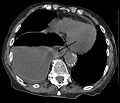Diaphragmatic hernia: Difference between revisions
CSV import |
CSV import |
||
| Line 33: | Line 33: | ||
{{stub}} | {{stub}} | ||
{{dictionary-stub1}} | {{dictionary-stub1}} | ||
<gallery caption="Diaphragmatic_hernia"> | |||
File:Peritoneopericardial_diaphragmatic_hernia.JPG|Peritoneopericardial diaphragmatic hernia | |||
File:Diaphragm_hernia2.jpg|Diaphragmatic hernia | |||
</gallery> | |||
Revision as of 00:46, 18 February 2025
Diaphragmatic hernia is a congenital defect or anomaly that occurs when the diaphragm fails to fully form, allowing parts of the abdomen to move into the chest cavity. This condition can affect the development of the lungs and other organ systems.
Causes
The exact cause of diaphragmatic hernia is unknown. However, it is believed to occur during the development of the fetus when the diaphragm fails to close completely. This allows the organs in the abdomen to move into the chest cavity, which can interfere with lung development.
Symptoms
Symptoms of diaphragmatic hernia can vary depending on the severity of the condition. They may include:
- Difficulty breathing
- Rapid breathing
- Cyanosis (bluish color of the skin)
- Abnormal chest development
Diagnosis
Diaphragmatic hernia can often be diagnosed before birth through a routine ultrasound. After birth, the condition can be confirmed through a chest X-ray or CT scan.
Treatment
Treatment for diaphragmatic hernia usually involves surgery to repair the defect in the diaphragm. This is typically done shortly after birth. In some cases, a procedure called fetal surgery may be performed before birth.
Prognosis
The prognosis for a child with a diaphragmatic hernia depends on the severity of the condition and the presence of other anomalies. With early diagnosis and treatment, many children with this condition can lead normal, healthy lives.





